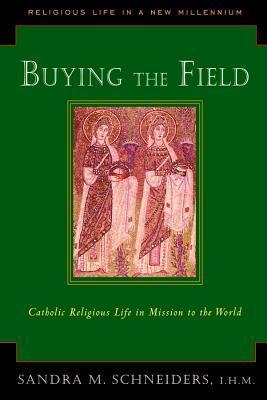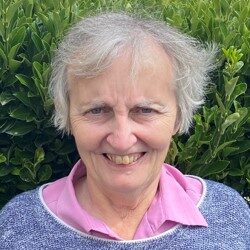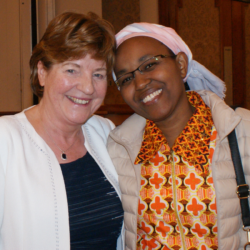Summer Seminar on Religious Life with Sandra Schneiders IHM, St. Mary’s Indiana, July 2014

I didn’t exactly expect a vacation when I went to Sandra Schneiders’ five-day seminar on religious life, but I found every moment of every day there crammed: challenging lectures, question times, discussions, thoughtful liturgies – yet surprisingly I was energized rather than tired at the end of it. Attending from various congregations were 240 of us, between retreat directors, parish staff, nurses, educators, pastoral and social workers; US missionaries to China, Korean missionaries to the US; candidates, associates, formators; human rights lobbyists, environment protectors, people active and retired. We had this golden opportunity to talk to each other about our lives, our experience—and to listen, both to Sandra Schneiders and to each other.
The unspoken questions in our minds, given the rocky road we have been on the last few years, went something like this: What are we about? Who are we? How relevant is who we are, or what we promise, in the world today? We found ourselves coming away with great hope and resolve: not to let others define our lives for us, to live up to our calling. There was also the really joyful experience of recognition: finally things were being said aloud that we always knew but didn’t have the words for.
The Lectures
Based largely on her most recent book Buying the Field (2013), Schneiders’ lectures laid out and developed a comprehensive definition of contemporary religious life. Like that storekeeper in Matthew who brings forth treasures new and old, she gave a new perspective on the vows and on community, and as a scripture scholar solidly founded these coordinates of religious life in our roots.

Her use of scriptural examples was marked by a clearly affective connection with the figures she has come to know there, especially in the Gospels, especially in John. This enabled her to bring us fresh insights into well-known characters or to tell stories freshly as they have resonated with her own spirit. We were allowed a glimpse of a lived connection to the Gospel, as well as being treated to top-of-the-line scholarship. Her discussion of the Prodigal Son was among the finest I had ever heard (Buying the Field 314-318). She situated our vow of Poverty in the Prophets and in Wisdom Literature before turning to the Gospels; what we are aiming for is an attitude like that of the Anawim, never self-sufficient, but glad to be dependent on God. Her discussion of Jesus as prophet among the people was inspiring.
A few of the concepts around which the lectures were built were – life form, ministerial, Economy of Gift, prophetic obedience. The concept of life form was particularly interesting. “I’m borrowing an organic metaphor,” said Schneiders. “A life form is a living thing, an organic reality that responds to its environment. You can take a lot of its parts away and it can still go on living, can still be itself.” Religious life, she told us, is the oldest life form in the church, older than the clerical life form, dating back in written texts to the 0080’s of the Christian Era.
While she found roots for each aspect of our lives in scripture, she also showed us how each of the vows was set against contemporary mores. We construct imaginatively a whole different alternate world within the world:
- not participating in the economy of acquisition
- not propagating our name by having children
- not driven by the politics of power and control.
- By means of the vows we model an alternate social reality, we demonstrate how it works. That’s our calling: to model, as well as to bring about, the Reign of God.
- We must seriously consider in our assemblies, as well as individually: how we get people to ask of themselves the questions our lives should provoke? What stands out when they see us?
- And whatever we can share of the life, we should.
Schneiders was an excellent and practiced lecturer. Her demeanor, to use an old-fashioned word, was impressively transparent, straight, humble. Though she spoke powerful words from a position of some authority – scholar, author, engaged with church and community for many decades – she didn’t stand on a pedestal to do it. Solidarity was the feeling one got: this was your sister, who was saying what made sense, who was challenging you and herself and the male establishment. She was modeling, in fact, one of the descriptors of a prophet—among us, involved in our lives. The audience could only hope that some of her vigor and conviction would transfer to us.
The Discussion Groups
Inter-congregational discussion groups of 8 – 10 people met for an hour and a half every afternoon. Sandra Schneiders encouraged us to put, as equal partners, our own experiences and wisdom in dialogue with whatever she had to say, and also observed, “It’s important to come together across congregational boundaries. We can, at community meetings, sometimes get the feeling we’ve been around a track too many times, but when we get together, we find out how others are perhaps dealing with the same things.” It was evident by the energy in the groups that talking about our issues and challenges can give us ideas, a new heart, and a sense of who we are as religious. Could more opportunities for inter-congregational meetings/workshops be organized down the road? Schneiders pointed out that the LCWR brings the community leaders together every year, and most professions have annual meetings, but we “troops on the ground” don’t!
 Sr. Mary O’Connor
Sr. Mary O’Connor
Footnote on the Trilogy I urge you to read these important books, alone or with others. Be grounded in the theology of your own life. Agree or argue with the text. Maybe do it as a preparation for the Year of Consecrated Life, 2015. There’s overlap in the three, so it might be just as well to start with the most recent, Buying the Field (2013), since that hefty volume brings in summaries of points the author made in the first two. For an in-depth discussion of particular vows, Buying the Field covers poverty and obedience and Selling All (2001) looks at celibacy and community, while the first of the trilogy, Finding the Treasure (2000), which many of you have already read, sets religious life in its human context and its ecclesial reality. But the vows, as Schneiders reminds us, are not three sets of obligations: they are three dimensions of a single reality, our religious life as prophetic lifeform in the church. During the Year of Consecrated Life you will be told many times who you are and what you are. Have your own mind made up, your own thoughts about that, before it begins.
Mary O’Connor rsm
US Province


